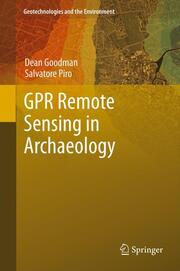Detailansicht
GPR Remote Sensing in Archaeology
Geotechnologies and the Environment 10, Geotechnologies and the Environment 9
ISBN/EAN: 9783642318566
Umbreit-Nr.: 3782802
Sprache:
Englisch
Umfang: xi, 233 S.
Format in cm:
Einband:
gebundenes Buch
Erschienen am 05.04.2013
Auflage: 1/2013
- Kurztext
- This book provides a complete description of the processes needed to take raw GPR data all the way to the construction of subsurface images. The book provides an introduction to the theory of GPR by using a simulator that shows how radar profiles across simple model structures look and provides many examples so that the complexity of radar signatures can be understood. The book continues with a review of the necessary radargram signal processes needed along with examples. The most comprehensive methodology to construct subsurface images from either coarsely spaced data using interpolation or from dense data from multi-channel equipment and 3D volume generation is presented. Advanced imaging solutions such as overlay analysis are introduced and numerous worldwide site case histories are shown. The authors present their studies in away that most technical and non-technical users of the equipment will find it useful for implementing in their own subsurface investigations.
- Autorenportrait
- Dr. Salvatore Piro has been part of the Consiglio Nazionale delle Ricerche (Institute of Technologies Applied to Cultural Heritage, ITABC-CNR) which, from early 1980, was one of the first governmental institutions worldwide to recognize the importance of geophysics in archaeological investigations. Salvatore has helped to advance the use of GPR and other geophysical techniques through the ITABC and the Ground Remote Sensing Lab he has worked at and directed since the 1980s. From the inception of this lab in early 1980s till now, his research has involved the development of acquisition, elaboration and interpretation techniques for archaeological prospection employing magnetic, earth resistance and ground penetrating radar methods. His recent research interest includes acquisition and processing of integrated geophysical methods for near surface investigations.Dr. Dean Goodman had a unique opportunity to work at a small archaeological geophysics lab of the University of Miami Japan Division from 1989-2008. Dean had significant support from the city of Nakajima Machi, the museum at Saitobaru in Miyazaki, and the Nara National Cultural Properties Research Institute where he also was a guest researcher for many years. Since 2001, Dean had the tremendous fortune to be 'adopted' by the US Forest Service Heritage Program, run at that time by Dr. Kent Schneider who helped to encourage and foster continued growth of software development at the Geophysical Archaeometry Laboratory.
